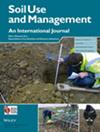利用pedotransfer函数和开放源码土壤数据绘制土壤腐蚀性潜能图,以便设置排阻围栏
IF 3.7
3区 农林科学
Q1 SOIL SCIENCE
引用次数: 0
摘要
土壤腐蚀性是一个术语,用于描述金属基础设施在不同土壤环境中的腐蚀敏感性(风险)。土壤腐蚀性测绘是确定潜在问题、高维护围栏线路的关键步骤,通过确定在哪些土壤环境中使用更昂贵、更耐腐蚀的材料从长远来看更具成本效益,从而有助于延长围栏的使用寿命。土壤腐蚀对隔离栅栏造成的损害可能会成为保护计划和措施的一个严重管理问题,因为这会削弱栅栏网的强度,并为入侵动物(如野猫和狐狸)迁徙和占据具有高保护价值的区域提供机会。地理空间分析软件的日益普及和开源土壤数据的可用性为土地管理者提供了机会,使他们能够利用数字土壤数据库和 pedotransfer 功能,使用通常测量的土壤属性制作栅栏腐蚀风险地图。本文利用开源政府机构土壤数据(形状文件)绘制了南澳大利亚约克半岛南部的围栏腐蚀风险图,目的是协助安装新的隔离(排他)围栏,作为 Marna Banggara 野化项目的一部分。将该地图进行的风险分类(低风险、中度风险和高度风险)与实地观察到的锌腐蚀率(锌损失量为 μm/年)进行了比较,结果正确预测了八个地点中五个地点的围栏受损程度。本研究中概述的绘图方法可供其他地区的环境管理者使用,为提高围栏寿命的策略提供参考。本文章由计算机程序翻译,如有差异,请以英文原文为准。
Mapping soil corrosivity potential to exclusion fencing using pedotransfer functions and open-source soil data
Soil corrosivity is a term used to describe the corroding susceptibility (risk) of metal infrastructure in different soil environments. Soil corrosivity mapping is a crucial step in identifying potentially problematic, high-maintenance fence lines and can help improve fence longevity by identifying soil environments where the use of more expensive, corrosion-resistant materials would be more cost-effective in the long term. Soil corrosion damage sustained on exclusion fences can be a serious management issue for conservation programs and initiatives, as it weakens the fence netting and provides opportunities for invasive animal migration and occupation (e.g. feral cats and foxes) into areas of high conservation value. The increasing accessibility of geospatial analysis software and the availability of open-source soil data provide land managers with the opportunity to implement digital soil databases and pedotransfer functions to produce fence corrosion risk maps using commonly measured soil attributes. This paper uses open-source government agency soil data (shapefiles) to map fence corrosion risk in the southern part of the Yorke Peninsula in South Australia, with the intention to assist with the installation of a new barrier (exclusion) fence as part of the Marna Banggara rewilding project. The risk classifications (low, moderate and high risk) made by this map were compared with rates of zinc corrosion (μm/year zinc loss) observed at field sites and correctly predicted the amount of fence damage sustained at five of the eight sites. The mapping approach outlined in this study can be implemented by environmental managers in other areas to inform strategies for enhancing fence longevity.
求助全文
通过发布文献求助,成功后即可免费获取论文全文。
去求助
来源期刊

Soil Use and Management
农林科学-土壤科学
CiteScore
7.70
自引率
13.20%
发文量
78
审稿时长
3 months
期刊介绍:
Soil Use and Management publishes in soil science, earth and environmental science, agricultural science, and engineering fields. The submitted papers should consider the underlying mechanisms governing the natural and anthropogenic processes which affect soil systems, and should inform policy makers and/or practitioners on the sustainable use and management of soil resources. Interdisciplinary studies, e.g. linking soil with climate change, biodiversity, global health, and the UN’s sustainable development goals, with strong novelty, wide implications, and unexpected outcomes are welcomed.
 求助内容:
求助内容: 应助结果提醒方式:
应助结果提醒方式:


